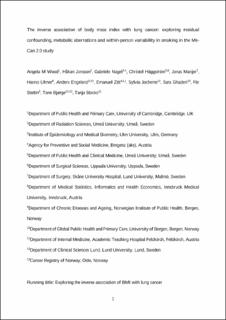| dc.description.abstract | Background: The inverse observational association between body mass index (BMI) and lung cancer risk remains unclear. We assessed whether the association is explained by metabolic aberrations, residual confounding, and within-person variability in smoking, and compared against other smoking-related cancers.
Methods: We investigated the association between BMI, and its combination with a metabolic score (MS) of mid-blood pressure, glucose, and triglycerides, with lung cancer and other smoking-related cancers in 778,828 individuals. We used Cox regression, adjusted and corrected for within-person variability in smoking (status/pack-years), calculated from 600,201 measurements in 221,958 participants.
Results: Over a median follow-up of 20 years, 20,242 smoking-related cancers (6,735 lung cancers) were recorded. Despite adjustment and correction for substantial within-person variability in smoking, BMI remained inversely associated with lung cancer [HR per standard deviation increase, 0.87 (95% confidence interval 0.85–0.89)]. Individuals with BMI less than 25 kg/m2 and high MS had the highest risk [HR 1.52 (1.44–1.60) vs. BMI ≥25 with low MS]. These associations were weaker and nonsignificant among nonsmokers. Similar associations were observed for head and neck cancers and esophageal squamous cell carcinoma, whereas for other smoking-related cancers, we generally observed positive associations with BMI.
Conclusions: The increased lung cancer risk with low BMI and high MS is unlikely due to residual confounding and within-person variability in smoking. However, similar results for other cancers strongly related to smoking suggest a remaining, unknown, effect of smoking.
Impact: Extensive smoking-adjustments may not capture all the effects of smoking on the relationship between obesity-related factors and risk of smoking-related cancers. | en_US |
